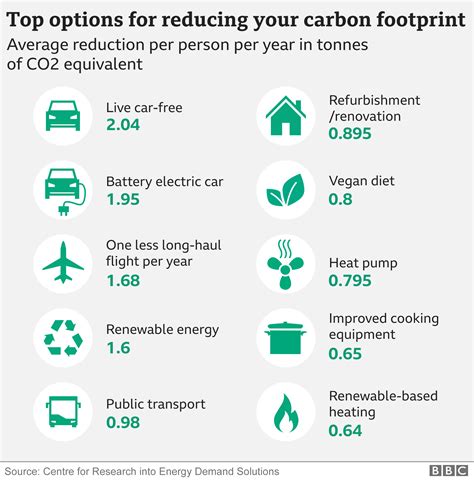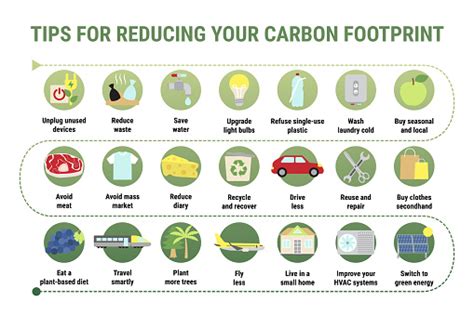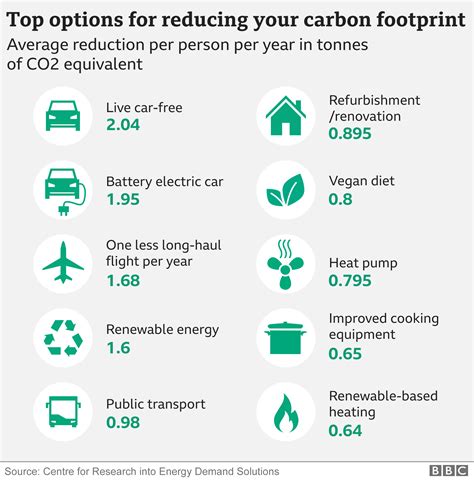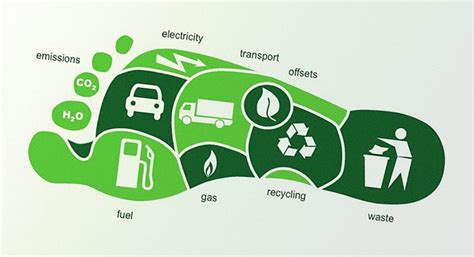Ways To Reduce Carbon Footprint

In today's world, where climate change is a pressing global concern, individuals and communities are increasingly recognizing the importance of taking action to mitigate their environmental impact. One crucial aspect of this effort is reducing our carbon footprint, the total amount of greenhouse gas emissions caused by our activities. By adopting sustainable practices and making conscious choices, we can significantly contribute to the fight against climate change and create a more sustainable future.
Understanding Carbon Footprint

A carbon footprint refers to the total greenhouse gas emissions caused by an individual, event, organization, or product. It includes carbon dioxide (CO2), methane (CH4), nitrous oxide (N2O), and other greenhouse gases, all of which trap heat in the Earth’s atmosphere, leading to global warming. Understanding our carbon footprint is the first step towards making informed decisions to reduce it.
The concept of carbon footprint has gained significant attention in recent years, with growing awareness about the environmental impact of human activities. Scientists and environmental organizations have developed various methods to calculate and quantify carbon footprints, providing individuals and businesses with tools to assess their environmental impact.
Factors Influencing Carbon Footprint
Several factors contribute to an individual’s carbon footprint. Transportation choices, such as using a personal vehicle, public transport, or opting for low-carbon alternatives like cycling or walking, significantly impact carbon emissions. Energy consumption at home, including heating, cooling, and electricity use, is another major factor. The products we buy, the food we consume, and the waste we generate also play a role in our carbon footprint.
| Category | Average Carbon Footprint |
|---|---|
| Transportation | Approximately 20-30% of an individual's carbon footprint |
| Home Energy | Varies based on location and energy sources, but can range from 10-20% |
| Food and Diet | Around 15-20%, with animal-based diets having higher carbon intensity |
| Consumption and Waste | Varies widely, but can contribute up to 10-15% |

Strategies to Reduce Carbon Footprint

Reducing our carbon footprint is not only beneficial for the environment but also often leads to cost savings and a healthier lifestyle. Here are some effective strategies to minimize our environmental impact.
1. Sustainable Transportation
One of the most significant ways to reduce carbon emissions is by opting for more sustainable transportation methods. This can include carpooling, using public transport, or even better, walking or cycling for shorter distances. Electric vehicles (EVs) are also becoming increasingly popular, offering a low-carbon alternative to traditional combustion engines. By reducing our reliance on fossil fuels for transportation, we can significantly lower our carbon footprint.
- Tips for Sustainable Transportation
- Plan your trips to reduce the number of journeys needed.
- Consider investing in an electric vehicle or a hybrid car.
- Explore bike-sharing or car-sharing programs in your area.
- Walk or cycle for shorter distances to stay active and reduce emissions.
2. Energy Efficiency at Home
Making our homes more energy-efficient is another crucial step in reducing carbon emissions. This can be achieved by upgrading to energy-efficient appliances, using smart thermostats to optimize heating and cooling, and improving home insulation. Additionally, adopting simple habits like turning off lights and electronics when not in use, and using energy-saving light bulbs, can significantly reduce energy consumption and lower our carbon footprint.
- Energy-Saving Tips for Your Home
- Install a programmable thermostat to control heating and cooling efficiently.
- Seal gaps and cracks in windows and doors to improve insulation.
- Replace old appliances with energy-efficient models.
- Use power strips to easily turn off multiple devices at once.
3. Sustainable Diet and Food Choices
The food we consume has a significant impact on our carbon footprint. Adopting a plant-based diet or reducing meat consumption can greatly lower our environmental impact. Plant-based foods generally have a lower carbon footprint than animal-based foods, especially those derived from intensive livestock farming. Additionally, reducing food waste is crucial, as it not only saves resources but also lowers the carbon emissions associated with food production.
- Sustainable Food Choices
- Opt for locally sourced and seasonal produce to reduce transportation emissions.
- Choose organic and sustainably produced foods to support eco-friendly farming practices.
- Reduce meat consumption, especially beef and lamb, which have higher carbon footprints.
- Plan meals and shop with a list to minimize food waste.
4. Sustainable Consumption and Waste Reduction
Our consumption habits and waste management practices also contribute to our carbon footprint. Adopting a minimalist lifestyle, buying second-hand, and choosing durable and repairable products can reduce the demand for new resources and lower emissions. Proper waste management, including recycling and composting, is crucial to reducing the environmental impact of waste disposal.
- Tips for Sustainable Consumption and Waste Reduction
- Buy second-hand or rent items instead of always buying new.
- Choose products with minimal packaging or opt for refillable options.
- Compost food waste and garden waste to reduce landfill emissions.
- Repair and reuse items whenever possible before considering disposal.
The Impact of Collective Action
While individual actions are crucial, collective efforts can have an even greater impact on reducing carbon footprints. Communities, organizations, and governments play a vital role in promoting sustainable practices and implementing policies to lower carbon emissions. By advocating for and supporting initiatives that promote sustainability, we can accelerate the transition towards a low-carbon future.
Community Initiatives for a Low-Carbon Future
Communities can come together to implement sustainable practices and create a collective impact. This can include community gardens, car-sharing programs, or even shared solar panel installations. By collaborating and sharing resources, communities can reduce their carbon footprint and build a more sustainable future.
Government Policies and Incentives
Governments have a crucial role in driving the transition towards a low-carbon economy. This can include implementing policies to promote renewable energy, incentivizing sustainable transportation, and setting targets for reducing greenhouse gas emissions. By supporting and advocating for such policies, individuals can influence government actions and accelerate the shift towards a more sustainable future.
Measuring and Monitoring Carbon Footprint
Measuring and monitoring our carbon footprint is essential to track our progress and identify areas for improvement. Various online tools and calculators are available to estimate an individual’s or organization’s carbon footprint. These tools consider factors such as transportation, energy use, and consumption habits to provide an estimate of our environmental impact.
Carbon Footprint Calculators and Tracking Apps
Carbon footprint calculators, such as those offered by the World Resources Institute and The Nature Conservancy, provide a comprehensive assessment of an individual’s or organization’s carbon emissions. These calculators consider various aspects of our daily lives, including transportation, energy use, and diet, to estimate our carbon footprint. Additionally, tracking apps can help individuals monitor their progress and set goals for reducing their environmental impact.
The Future of Carbon Footprint Reduction

As the world continues to prioritize sustainability and combat climate change, the focus on reducing carbon footprints will only grow. Technological advancements and innovations in renewable energy, transportation, and sustainable practices will play a crucial role in achieving a low-carbon future. By embracing these advancements and adopting sustainable lifestyles, we can create a more environmentally conscious and resilient world.
Emerging Technologies and Innovations
Advancements in renewable energy, such as solar and wind power, offer promising solutions for reducing carbon emissions. Additionally, innovations in electric vehicle technology, energy storage systems, and sustainable materials are transforming various industries and reducing their environmental impact. By supporting and investing in these technologies, we can accelerate the transition towards a more sustainable future.
Conclusion
Reducing our carbon footprint is not only a responsibility but also an opportunity to create a healthier and more sustainable world. By adopting sustainable practices, making conscious choices, and advocating for collective action, we can significantly lower our environmental impact. Together, we can shape a future where climate change is addressed, and a low-carbon economy becomes the norm.
What is the significance of reducing our carbon footprint?
+Reducing our carbon footprint is crucial for mitigating climate change and its impacts. By lowering greenhouse gas emissions, we can help stabilize the Earth’s climate, protect ecosystems, and ensure a sustainable future for generations to come.
How can I calculate my carbon footprint?
+You can use online carbon footprint calculators provided by organizations like the World Resources Institute or The Nature Conservancy. These calculators consider various aspects of your lifestyle and provide an estimate of your carbon emissions.
What are some simple changes I can make to reduce my carbon footprint?
+Simple changes include reducing meat consumption, opting for energy-efficient appliances, using public transport or cycling, and properly managing waste through recycling and composting.
How can I advocate for carbon footprint reduction at a community level?
+You can engage with local community groups, participate in sustainable initiatives, and advocate for policies that promote renewable energy, sustainable transportation, and waste reduction. Collaborating with others can amplify your impact.


